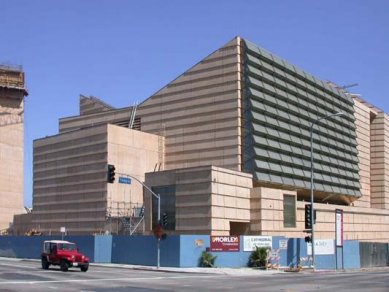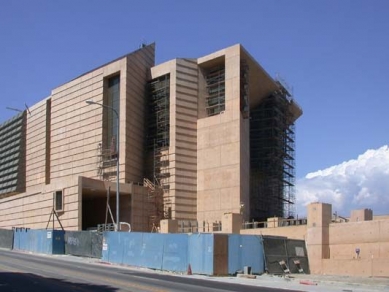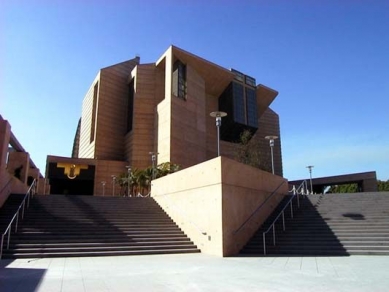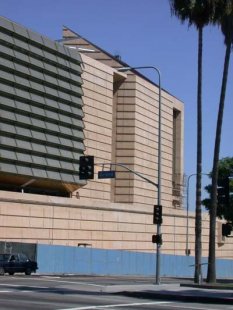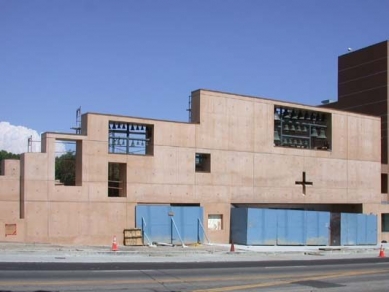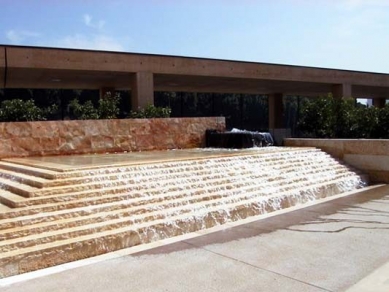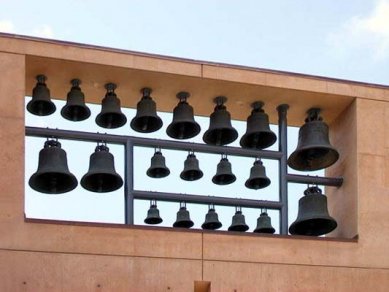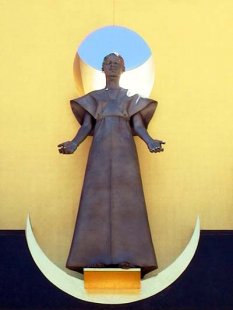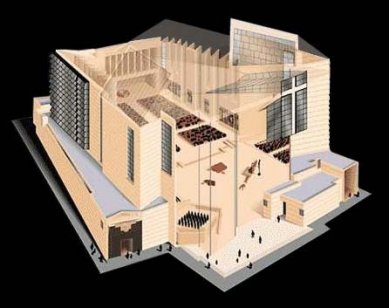
Cathedral of Our Lady of the Angels

Rafael Moneo does not churn out projects like a conveyor belt. He spends most of the year in academia and his buildings only confirm his qualities in everyday life. Lidové noviny has a similar spirit. They do not aim to please everyone and do not indulge in the mainstream. They surprisingly report on architecture as well (the project of John Pawson in Nový Dvůr, ...). A report on Moneo's cathedral in LA shocked me. The only mention of the project I found was in El Croquis and Domus two years ago. Lidové noviny were the first in Europe to mention the completion of the work. I bring you a summary of information about this building.
Building a functional cathedral is, even at the beginning of the twenty-first century, a science and at the same time a challenge for creators. The architect of the Cathedral of Our Lady of the Angels in downtown Los Angeles, José Rafael Moneo, responded to it with a grand and at the same time controversial project for many believers, which will undoubtedly join the family of world church buildings. The cathedral, which can seat three thousand worshippers at once, was ceremonially opened to the public on September 3.
The Los Angeles metropolitan area covers a vast area; in an area twenty-one times larger than Prague, nine and a half million people live in eighty-eight interconnected cities. The city of Los Angeles is relatively young, having been founded in 1781. In Europe, cathedrals were usually built by rivers. In Los Angeles, the creators deemed the Hollywood Freeway as a kind of river of modern times. It is a striking building that often serves as a landmark in urban planning. It is meant to serve people who come here for worship purposes, while also providing an artistic experience for others. The Cathedral of Our Lady of the Angels on Temple Street in the heart of the city is intended to serve 3.6 million California believers as the main stage of the Christian world. As history shows, no great building is without controversy, and this one has not escaped problems and confrontations.
Forty-six architects initially expressed interest in response to the jury's challenge. The winning design came from Spanish architect José Rafael Moneo. The construction took five years and spans five and a half hectares, including a parking lot for 600 cars. It is constructed to withstand an earthquake of 8.4 on the Richter scale. California has never experienced such strength. During tremors, the entire structure can shift up to 72 centimeters in any direction. The separate bell tower stands at a height of fifty meters. The interior of the cathedral is lined with sandstone in the color of unburnt clay bricks. It feels like a warm, welcoming place bathed in sunlight that streams through huge alabaster windows. The main nave is 111 meters long, slightly longer than that of New York's St. Patrick's Cathedral.
Many people believe that the cathedral is simply a large church. However, the distinguishing feature of every cathedral is the bishop's chair, which symbolizes the bishop's role as a successor of the apostles in teaching and preaching the word of God. The architecture of the cathedral and its interior decoration have received positive evaluations from experts locally and nationally. However, the public mostly sees the building as a "yellow bunker" and criticizes primarily its commercial aspects and the exorbitant cost of 195 million dollars, into which are included achievements that the average believer will not be able to afford. Under the floor is a mausoleum with 1,270 crypts and five thousand niches for burial urns. Spaces are sold for fifty thousand dollars only to the wealthiest of the wealthy, such as media magnate Rupert Murdoch or former mayor Richard Riordan.
Traditionalist circles have also expressed astonishment at the fact that the cathedral somewhat "withdraws from the street." However, Moneo intended to create a "private space." In one interview, he stated: "I want to offer people a space where it will be easier for them to disconnect from everyday life. I want to give them a chance to rise higher." Thus, he did not want the entrance to be directly from the street. "Believers and visitors must go through a spiritual journey. Each step will be a transition from the secular sphere to the sacred sphere."
The bronze entrance doors by Robert Graham welcome visitors like open arms. They are meant to reflect the diverse society - bearing, for example, the Japanese symbol of heaven, a Jewish representation, a Taoist symbol for harmony, an image of a dog representing loyalty, a peacock as a symbol of rebirth, an evangelical cross, a bowl of coffee from Samoa, and a vessel wrapped in a vine, symbolizing the church that unites all. The upper panels of the entrance doors pay tribute to the Virgin Mary in various cultural interpretations. There is the Mexican Virgin of Guadalupe, Peruvian Virgin Pomata, Colombian Chiquinquira, Spanish Montserrat, and many others. The crown of the doors is formed by a life-size Mary. She is not white, black, Asian, or Hispanic. Her ethnicity belongs to everyone. The walls of the temple are adorned with tapestries by John Nava, depicting holy communion. The faces of the saints resemble ordinary people we might meet on the streets of Southern California. The cathedral includes a plaza covering two and a half acres and a vast garden with olive trees and palm trees, reminiscent of the Holy Land. There are also fountains and waterfalls designed to evoke the diversity of California. One fountain, for example, is a dramatic reference to solidarity with the Jews, while another is meant to remind of the living water.
When the cathedral was ceremonially opened to the public, a procession of three thousand pilgrims included Nigerian and Scottish drummers, a family carrying sacred relics, and seven hundred priests, bishops, and cardinals. Los Angeles Cardinal Roger E. Mahony welcomed them at the entrance doors, a man who fully understood the architect's intention when he stated: "The main themes of this cathedral are light and journey." The cardinal hopes that "the cathedral will not only be a center of city life, church ceremonies, and prayer, but also a symbol that evokes the deepest aspirations and hopes of the entire metropolis."
Petr Šmídek, 2001
Building a functional cathedral is, even at the beginning of the twenty-first century, a science and at the same time a challenge for creators. The architect of the Cathedral of Our Lady of the Angels in downtown Los Angeles, José Rafael Moneo, responded to it with a grand and at the same time controversial project for many believers, which will undoubtedly join the family of world church buildings. The cathedral, which can seat three thousand worshippers at once, was ceremonially opened to the public on September 3.
The Los Angeles metropolitan area covers a vast area; in an area twenty-one times larger than Prague, nine and a half million people live in eighty-eight interconnected cities. The city of Los Angeles is relatively young, having been founded in 1781. In Europe, cathedrals were usually built by rivers. In Los Angeles, the creators deemed the Hollywood Freeway as a kind of river of modern times. It is a striking building that often serves as a landmark in urban planning. It is meant to serve people who come here for worship purposes, while also providing an artistic experience for others. The Cathedral of Our Lady of the Angels on Temple Street in the heart of the city is intended to serve 3.6 million California believers as the main stage of the Christian world. As history shows, no great building is without controversy, and this one has not escaped problems and confrontations.
Forty-six architects initially expressed interest in response to the jury's challenge. The winning design came from Spanish architect José Rafael Moneo. The construction took five years and spans five and a half hectares, including a parking lot for 600 cars. It is constructed to withstand an earthquake of 8.4 on the Richter scale. California has never experienced such strength. During tremors, the entire structure can shift up to 72 centimeters in any direction. The separate bell tower stands at a height of fifty meters. The interior of the cathedral is lined with sandstone in the color of unburnt clay bricks. It feels like a warm, welcoming place bathed in sunlight that streams through huge alabaster windows. The main nave is 111 meters long, slightly longer than that of New York's St. Patrick's Cathedral.
Many people believe that the cathedral is simply a large church. However, the distinguishing feature of every cathedral is the bishop's chair, which symbolizes the bishop's role as a successor of the apostles in teaching and preaching the word of God. The architecture of the cathedral and its interior decoration have received positive evaluations from experts locally and nationally. However, the public mostly sees the building as a "yellow bunker" and criticizes primarily its commercial aspects and the exorbitant cost of 195 million dollars, into which are included achievements that the average believer will not be able to afford. Under the floor is a mausoleum with 1,270 crypts and five thousand niches for burial urns. Spaces are sold for fifty thousand dollars only to the wealthiest of the wealthy, such as media magnate Rupert Murdoch or former mayor Richard Riordan.
Traditionalist circles have also expressed astonishment at the fact that the cathedral somewhat "withdraws from the street." However, Moneo intended to create a "private space." In one interview, he stated: "I want to offer people a space where it will be easier for them to disconnect from everyday life. I want to give them a chance to rise higher." Thus, he did not want the entrance to be directly from the street. "Believers and visitors must go through a spiritual journey. Each step will be a transition from the secular sphere to the sacred sphere."
The bronze entrance doors by Robert Graham welcome visitors like open arms. They are meant to reflect the diverse society - bearing, for example, the Japanese symbol of heaven, a Jewish representation, a Taoist symbol for harmony, an image of a dog representing loyalty, a peacock as a symbol of rebirth, an evangelical cross, a bowl of coffee from Samoa, and a vessel wrapped in a vine, symbolizing the church that unites all. The upper panels of the entrance doors pay tribute to the Virgin Mary in various cultural interpretations. There is the Mexican Virgin of Guadalupe, Peruvian Virgin Pomata, Colombian Chiquinquira, Spanish Montserrat, and many others. The crown of the doors is formed by a life-size Mary. She is not white, black, Asian, or Hispanic. Her ethnicity belongs to everyone. The walls of the temple are adorned with tapestries by John Nava, depicting holy communion. The faces of the saints resemble ordinary people we might meet on the streets of Southern California. The cathedral includes a plaza covering two and a half acres and a vast garden with olive trees and palm trees, reminiscent of the Holy Land. There are also fountains and waterfalls designed to evoke the diversity of California. One fountain, for example, is a dramatic reference to solidarity with the Jews, while another is meant to remind of the living water.
When the cathedral was ceremonially opened to the public, a procession of three thousand pilgrims included Nigerian and Scottish drummers, a family carrying sacred relics, and seven hundred priests, bishops, and cardinals. Los Angeles Cardinal Roger E. Mahony welcomed them at the entrance doors, a man who fully understood the architect's intention when he stated: "The main themes of this cathedral are light and journey." The cardinal hopes that "the cathedral will not only be a center of city life, church ceremonies, and prayer, but also a symbol that evokes the deepest aspirations and hopes of the entire metropolis."
The English translation is powered by AI tool. Switch to Czech to view the original text source.
0 comments
add comment


